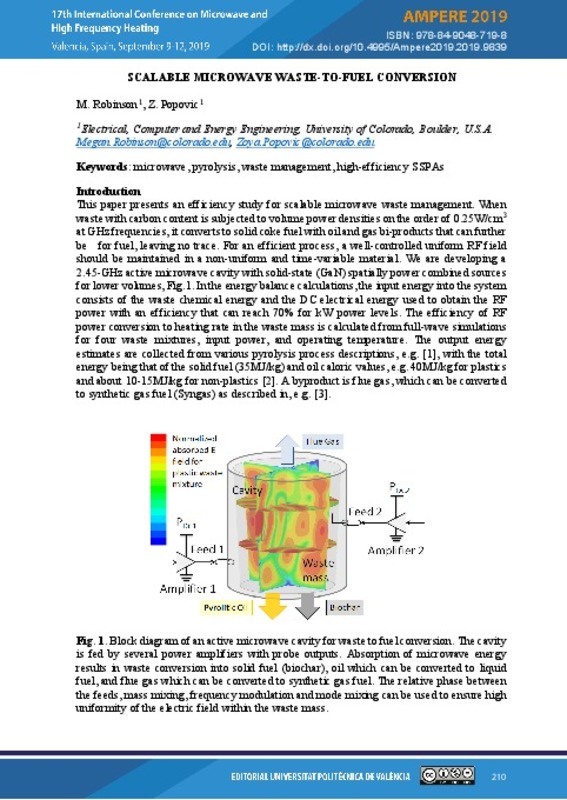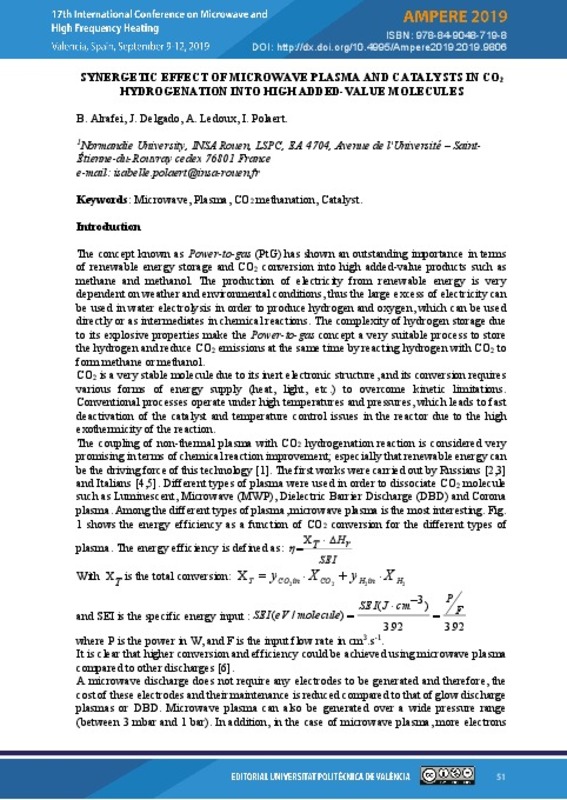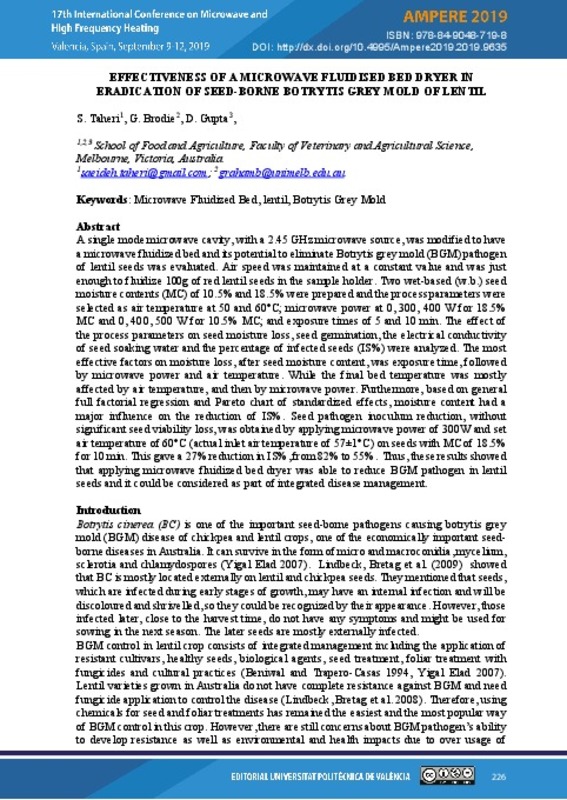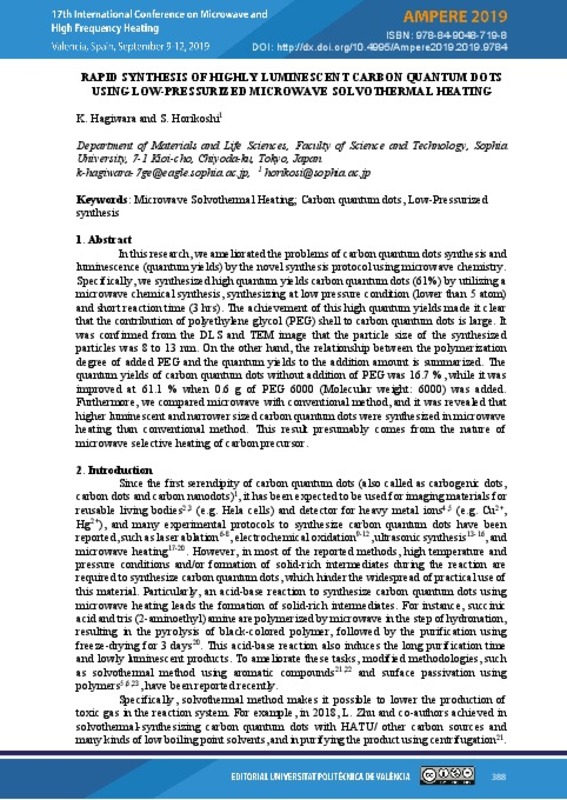JavaScript is disabled for your browser. Some features of this site may not work without it.
Buscar en RiuNet
Listar
Mi cuenta
Estadísticas
Ayuda RiuNet
Admin. UPV
Scalable microwave waste-to-fuel conversion
Mostrar el registro sencillo del ítem
Ficheros en el ítem
| dc.contributor.author | Robinson, Megan
|
es_ES |
| dc.contributor.author | Popovic, Zoya
|
es_ES |
| dc.date.accessioned | 2019-11-13T09:11:59Z | |
| dc.date.available | 2019-11-13T09:11:59Z | |
| dc.date.issued | 2019-10-15 | |
| dc.identifier.isbn | 9788490487198 | |
| dc.identifier.uri | http://hdl.handle.net/10251/130891 | |
| dc.description.abstract | [EN] This paper presents an efficiency study for scalable microwave waste management. When waste with carbon content is subjected to volume power densities on the order of 0.25W/cm3 at GHz frequencies, it converts to solid coke fuel with oil and gas bi-products that can further be processed for fuel, leaving no trace. For an efficient process, a well-controlled uniform RF field should be maintained in a non-uniform and time-variable material. We are developing a 2.45-GHz active microwave cavity with solid-state (GaN) spatially power combined sources for lower volumes, Fig.1. In the energy balance calculations, the input energy into the system consists of the waste chemical energy and the DC electrical energy used to obtain the RF power with an efficiency that can reach 70% for kW power levels. The efficiency of RF power conversion to heat in the waste mass is calculated from full-wave simulations for typical waste mixtures and ranges from 10 to 90% depending on the material and cavity filling. The output energy estimates are collected from various pyrolysis process descriptions, e.g. [1], with the total energy being that of the solid fuel (35MJ/kg) and oil caloric values, e.g. 40MJ/kg for plastics and about 10-15MJ/kg for nonplastics [2]. A byproduct is flue gas which can be converted to Syngas [3]. The total worse-case carbon footprint balance (0.3-3) calculations will be presented. Fig. 1. Block diagram of active microwave cavity for waste to fuel conversion. References D. Czajczyńska, “Potential of pyrolysis processes in the waste management sector,” Thermal Science and Engineering Progress, vol. 3, p. 171. Sept., 2017. J.A. Onwudili, “Composition of products from the pyrolysis of polyethylene and polystyrene in a closed batch reactor: effects of temperature and residence time,” Journal of Analytical and Applied Pyrolysis, vol. 86 p. 293–303. Nov., 2009. S. Chunshan, "Tri-reforming of methane: a novel concept for synthesis of industrially useful synthesis gas with desired H2/CO ratios using CO2 in flue gas of power plants without CO2 separation." Prepr. Pap.-Am. Chem. Soc., Div. Fuel Chem 49, no. 1 (2004): 128. | es_ES |
| dc.description.sponsorship | This work was funded by DARPA under contract W911NF-18-1-0073. | es_ES |
| dc.format.extent | 7 | es_ES |
| dc.language | Inglés | es_ES |
| dc.publisher | Editorial Universitat Politècnica de València | es_ES |
| dc.relation.ispartof | AMPERE 2019. 17th International Conference on Microwave and High Frequency Heating | es_ES |
| dc.rights | Reconocimiento - No comercial - Sin obra derivada (by-nc-nd) | es_ES |
| dc.subject | Energy Production by Microwaves | es_ES |
| dc.subject | Microwave CVD | es_ES |
| dc.subject | EM Modelling | es_ES |
| dc.subject | Microwave Material interaction | es_ES |
| dc.subject | Dielectric Properties | es_ES |
| dc.subject | Dielectric Properties Measurement | es_ES |
| dc.subject | Solid State Microwave | es_ES |
| dc.subject | Microwave Processing | es_ES |
| dc.subject | Microwave Chemistry | es_ES |
| dc.subject | Microwave applicators design | es_ES |
| dc.title | Scalable microwave waste-to-fuel conversion | es_ES |
| dc.type | Capítulo de libro | es_ES |
| dc.type | Comunicación en congreso | es_ES |
| dc.identifier.doi | 10.4995/AMPERE2019.2019.9839 | |
| dc.relation.projectID | info:eu-repo/grantAgreement/DOD//DARPA-W911NF-18-1-0073/ | |
| dc.rights.accessRights | Abierto | es_ES |
| dc.description.bibliographicCitation | Robinson, M.; Popovic, Z. (2019). Scalable microwave waste-to-fuel conversion. En AMPERE 2019. 17th International Conference on Microwave and High Frequency Heating. Editorial Universitat Politècnica de València. 210-216. https://doi.org/10.4995/AMPERE2019.2019.9839 | es_ES |
| dc.description.accrualMethod | OCS | es_ES |
| dc.relation.conferencename | Ampere 2019 | es_ES |
| dc.relation.conferencedate | Septiembre 09-12,2019 | es_ES |
| dc.relation.conferenceplace | Valencia, Spain | es_ES |
| dc.relation.publisherversion | http://ocs.editorial.upv.es/index.php/AMPERE2019/AMPERE2019/paper/view/9839 | es_ES |
| dc.description.upvformatpinicio | 210 | es_ES |
| dc.description.upvformatpfin | 216 | es_ES |
| dc.type.version | info:eu-repo/semantics/publishedVersion | es_ES |
| dc.relation.pasarela | OCS\9839 | es_ES |
| dc.contributor.funder | U.S. Department of Defense |
Este ítem aparece en la(s) siguiente(s) colección(ones)
-
Ampere 2019 [66]











